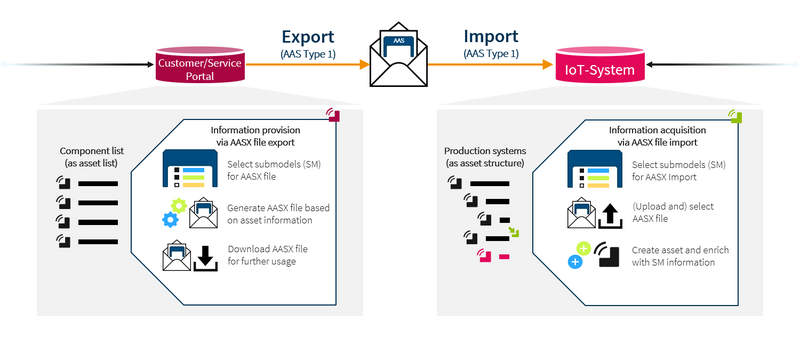Press release - March 31, 2023
CONTACT researches simplified AAS integration
As part of the AASHub research project, CONTACT Software has expanded its IoT platform with import and export functionality for the AAS. This enables the standardized integration of IoT components into digital twins and accelerates Industry 4.0 processes.
The digital twin is a key technology for the Industry 4.0. It holds the as-maintained condition of an asset, from its serial number to real-time operational data. To ensure that digital twins can interact with each other, asset information can be stored in a standardized exchange format: the Asset Administration Shell (AAS). The AAS allows for vendor-neutral end-to-end communication between different assets, systems, and organizations, thereby increasing efficiency and productivity. For example, by providing all relevant product information for maintenance as well as a standardized maintenance request in the form of a submodel.
As part of the AASHub research project, CONTACT and partners developed a solution for the exchange of AASs between different software systems. It is intended, among other things, to simplify the integration of IoT components into the digital twin of an existing plant.
The project was coordinated by the Ruhr University Bochum and funded by EIT Manufacturing. Together with project partners Böllhoff Group, Prima Industrie, and ifm electronic, CONTACT explored two use cases for the AASHub. Both are based on CONTACT Elements for IoT, which was expanded to include functionality for the export and import of the AAS. The project focused on AASs of type 1, which are exchanged via AASX files.
In the first use case, users access a customer portal based on Elements for IoT to download their product’s AAS. Once they have selected their product and specified the relevant submodels, Elements for IoT automatically generates the AAS and provides it as an AASX file.
The second use case addresses the import of AAS information into Elements for IoT, where it is integrated into a digital twin or used to create a new one. For this purpose, users upload the relevant submodels of the AASX file into the platform via the import function. This use case comes into play when Elements for IoT is deployed as a production-related system or in the management of smart products.
“With the import and export functions, we significantly increase the degree of automation for the integration of an IoT component into a digital twin,” says Dr. Thomas Dickopf of CONTACT Research. CONTACT will leverage the learnings from the project to expand its Elements platform with provisioning and integration mechanisms for the AAS.
As a member of the Industrial Digital Twin Association (IDTA), CONTACT contributes to the standardization of the AAS and its submodels with the aim to enable interoperability in heterogenous component landscapes.



